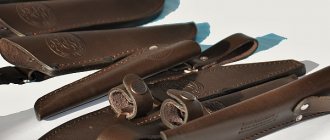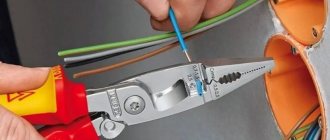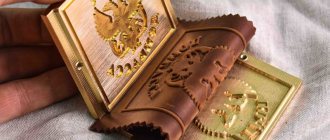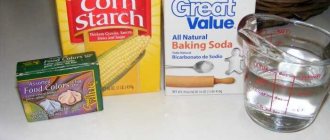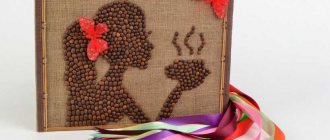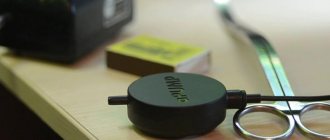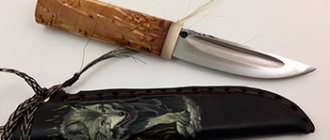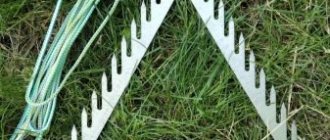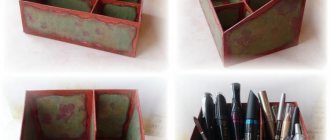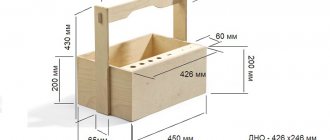The sheath is the “clothing” for a knife, which should be of high quality and comfortable. You can make them yourself using a standard set of tools and the material you like - leather, wood or plastic.
It is important to complete the first stage and make patterns/patterns exactly according to the size of the knife; then everything depends on practical skills: you will need to sew the blanks, clean them and cover them with stain or varnish or paint.
The most popular are leather sheaths - lightweight, practical, durable and easy to make with your own hands.
General information about the scabbard
A sheath is a product designed for carrying and storing edged weapons. They protect the owner and surrounding people from accidental injury from a sharp blade and prevent the appearance of rust on the metal. If you need to organize the storage of collectible, expensive, exclusive models of knives, then the sheath can be made with decor from precious stones, gold, and silver.
For the manufacture of sheaths, various materials are used, which will be characterized by increased strength - genuine leather, hardwood, metal, thick fabric, plastic.
We recommend reading the article about the unusual pchak knife. From it you will learn about what a pchak is, types of Uzbek knife, handmade pchaks from Bakhrom Yusupov, how to make an Uzbek pchak knife with your own hands. And here is more information about the best hunting knives.
Materials you can make with your own hands
You can make a sheath with your own hands from the following materials:
- a natural skin;
- wood - hardwood only;
- plastic.
| Material name | Advantages | Flaws |
| Genuine Leather | The material is dense, will last a long time as a finished product, affordable | Working with leather is difficult (requires some skills), requires specific care, remains soft |
| Wood – beech, oak, walnut | Reliability of the finished product, it is possible to decorate the sheath with decor or paints | Working with hard wood is very difficult; for fastening you will need to make hinges from leather |
| Plastic | Waterproof, has a long service life, can be washed even with aggressive agents, inexpensive | To carry out the work you will need a professional construction hair dryer |
Types of fastenings
Depending on what the knife is intended for, the types of sheath mounts differ:
- traditional (worn on the belt);
- combat (shoulder, hip);
- special (suitable only for those who want to hide the presence of bladed weapons);
- image (applies only to folk traditions and the conditions for observing attire at ceremonial parades).
On the thigh
Combat knives are worn below the waist on the hip - this is typical for the military, but is also suitable for professional hunters or wilderness survivalists. In this case, the sheath is fixed to the thigh with a belt or cord at the lower end; the upper part can be additionally secured to the belt - this is especially true for large cutting tools.
Carrying a knife this way is quite specific: it is inconvenient for an untrained person to remove it, and there is a high probability that a leg injury will occur.
On the belt
A knife is attached to a belt by both amateurs and professionals - this method can be called a belt method and is considered universal. In this case, the weapon can be worn on the left or right side, for which the scabbard is structurally provided with left-handed/right-handed hangers; there is also an option for a double-handed hanger - you can place the knife on any convenient side. The latter type of fastening allows you to carry the cutting tool on a belt both at the back and at the front.
The disadvantage of this type of carrying is the difficulty of removing the knife from the sheath while sitting or lying down.
Shoulder
The shoulder sheath mount is most often used for combat knives. It is a wide cord that is threaded through a loop in the sheath and fixed on the shoulder or forearm. The knife is worn with this mount only with the handle down.
Only specially trained people can safely carry knives with a shoulder mount; amateurs are better off not taking risks - and taking out a weapon without specific skills is extremely inconvenient, and the risk of damage to the skin, soft tissues and even the periosteum is very high.
To the fisherman's vest
On the fisherman’s vest, the place for attaching the knife is pre-thought out, because this tool can save a person’s life - for example, if a fisherman fell into the water and became entangled in his own or someone else’s nets, then a quickly removed knife in his hands will solve the problem.
The weapon must be attached to the fisherman's vest with the hilt downward - this way it will be convenient to take it out. If the vest does not have a special pocket-compartment for weapons, then you will need to attach it to the sheath on special loops.
Watch the video on how to attach a knife to a fisherman’s vest:
Which ones are suitable for a dagger, hunting knife
For a hunting knife and dagger, you should choose a belt mount and here's why:
- the easiest and most affordable way;
- the knife/dagger is located on the right or left side (where the “working” hand is located);
- the weapon is positioned with the blade down.
If the dagger is an element of traditional clothing (for example, Cossacks or Caucasian warriors), then it is worn according to the rules, for example, in a sheath on a hanging belt hanging down on the hip.
Sheath for a hunting knife Sheath for a dagger
How to carry knives
The question is quite sensitive and multifaceted. It all depends on where and when you are going to wear the blade. Quite often, people are interested in how to properly carry folding knives in the city. After all, in our society, a knife has begun to be perceived as a threat to society. In Rus', it was difficult to imagine a man without a knife. It was everyday wear for household needs.
According to statistics, today about 10% of men in Russia wear folded pants. If the knife is not a bladed weapon, then there should be no problems with law enforcement agencies. Well, if you have a blade with you that is suitable for chemical weapons in all respects, then be so kind as to carry the documents for it with you.
Option for carrying a knife.
There are quite a few ways to carry knives, from simply on a belt to more sophisticated options. Essentially, they are divided into four main types:
- traditional, belt civilian;
- combat, when you need the speed of drawing the blade;
- special, professional and unusual ways;
- image, traditions of peoples, ceremonial options, etc.
The simplest and most common option is simple civilian. If you are right-handed, then the sheath is placed on the left side of the belt and vice versa. It’s easy enough to remove it when needed and it’s unlikely to get lost or caught on anything. Stores almost always have such options in stock.
Combat options are based on its size. It can be placed: in the armpit area, on the thigh, in the chest area, and the “boot” option is also not bad, the main thing is the speed of retrieving the blade. Sometimes it is placed on the back in the lumbar region, and if the blade is small, it is hung around the neck with a cord.
Previous
National knivesEvenki knife - Siberian folk tool
Next
Making knivesHow to make a knife from a file
Tools and auxiliary materials to make a knife sheath with your own hands
The most popular are knife sheaths made of leather, and to make them yourself, you will need the following tools:
- PVA glue;
- pencil, ruler - regular stationery/school ones;
- kitchen fork;
- nylon threads of maximum strength - can be replaced with a thin cord;
- Scotch tape - replaced with cling film;
- paraffin;
- thick paper, cardboard - several sheets of A4 format;
- stain;
- special glue for gluing leather, can be replaced with “Moment”;
- drill and drill bit 1mm (diameter);
- a fragment of cotton fabric, which is already impregnated with epoxy resin;
- sandpaper with a fine abrasive coating;
- office clips;
- sewing awl with hook;
- shoe polish or special wax for polishing leather products;
- scissors, a stationery knife with a supply of blades;
- vodka.
A set of tools for working with leather
If you plan to make a sheath from wood, then you should additionally prepare a jigsaw, a cutter for cutting out decor, impregnation (linseed oil), varnish, and sandpaper with a coarse abrasive surface.
Logo laying on
I put my cliche on all my products.
Let's continue.
Using a honing knife, I trim away the excess skin from the holster loop to make it thinner. This loop will secure the holster and hold the gun in place. At this stage, you can use not a knife, which is difficult for a beginner to work with, but a special polishing tool.
DIY leather sheath: step-by-step instructions
You need to make a leather sheath with your own hands in strict accordance with the step-by-step instructions:
- Make a liner from waterproof fabric (cotton, impregnated with epoxy resin), attach a knife to it, wrap it and cut it exactly to the size of the weapon.
- Cut the leather according to preliminary drawings, which can be made on thick paper or directly on the material - the knife blade is outlined with a pencil, 0.5 cm overlaps are made.
- Using PVA glue, fix the liner made of waterproof fabric on the leather blank (from the inside), wait until it dries completely - on average about 24 hours.
- Wrap the finished workpiece around the knife blade and secure the edges with paper clips.
- Use a sewing awl to make holes and stitch the workpiece so that “at the exit” it becomes a cover.
- Use a utility knife to cut off the excess edge.
This is an algorithm for the simplest sheath, which allows you to carry a cutting tool in a backpack, in a pants pocket, or in a belt.
Watch the video on how to make a leather sheath with your own hands:
Where to get leather
You can take leather to make a sheath from any no longer needed product, for example, jackets, boot tops, bags, even a purse or man purse will do. It is important to use really high-quality material - natural, without visible damage or scuffs. You just need to choose the size of the leather fragment, because it should be enough for the product - it is not customary to sew a sheath from pieces, and this is not practical; later it will interfere with the active use of the knife.
Optimal skin thickness
The thickness of the leather should be large - a saddle cloth, floor or collar would be an excellent choice. It should be of the saddlery type and vegetable tanned. If leather is not bought in specialized stores, but is taken from already unnecessary products, then you need to control its thickness, which should be no less than 2.5 mm and no more than 4 mm.
Skin structure and topography
How to make a pattern
The pattern is first made on cardboard or a sheet of thick paper. You need to put a knife blade on it, outline it with a pencil, then add 5-10 mm to the initial outline and draw a new line - this is exactly the place of the cutout. The length of the pattern is made 2.5-3 times longer than the real one, and the full parameter of the knife (including the handle) is taken into account.
The second part of the sheath is made according to the same principle, but without taking into account the handle.
The finished cardboard pattern is applied to the prepared piece of leather (from the wrong side). To prevent it from slipping, you need to pin it with pins. Next, a contour is drawn on the skin clearly according to the pattern, and the blank is cut out with scissors.
Sketch on a piece of paper Leather blank
How to sew it yourself
You can sew a leather sheath with your own hands using one seam. In this case, you will need to draw a line for the future seam from the edge of the leather blank, retreating 0.5-1 cm. Holes and seams are made with an awl, at the end of which there is a hook - it will be convenient to pull the nylon thread. The thickness of the awl is selected according to the thickness of the thread/cord - the holes from it should not be too noticeable on the material. All knots are made hidden, that is, they remain inside the sheath.
If the sheath is sewn with a double seam, then you will need to use a drill with a drill with a diameter of 1 mm to make holes along the line of the future seams - they run parallel to each other, repeating the contour of the sheath. Next, the steps are repeated: you need to connect two pieces of the product using an awl and a nylon cord.
Using an awl and a nylon cord, connect two pieces of the product
Leather sheath
Submersible leather sheaths can be made for small knives that are used for fishing or while picking mushrooms. They are made according to the same algorithm as standard ones, but the patterns are made the same - the knife must be completely hidden, including the handle. These cases are perfect for carrying and storing cutting tools while fishing, picking mushrooms, or hiking in the forest.
To make it easier to carry a knife in a submersible sheath, you need to make a loop, which is made of leather. The material must be cut into strips no more than 2 cm wide.
Finished scabbard
The loop is fixed on the inside of the sheath by making holes with an awl with a hook or a drill with a drill bit with a diameter of 1 mm. You can hide the seams on the outside of the sheath by gluing a piece of leather overlay.
How to make a twist
A twist is a case for carrying and storing a set of professional knives, often used by chefs who work “on the road.” For manufacturing, in addition to the standard set of materials and tools, you will need magnets - they are sewn into the skin and securely hold the tools.
The twist is done as follows:
- A leather pattern is prepared along the length of the longest knife and the width of the entire set. It is necessary to place the tools at a distance of 3-5 cm from each other, and this parameter should be measured not by the handle, but by the blade. The pattern should be 5 cm larger on each side than the measurements taken. There should be two ready-made patterns.
- One pattern is laid out on the table, and the contours of the future location of the knives are applied to it with a pencil or the tip of an awl. A magnet is placed in the middle of each “drawing” (presumably where the middle of the blade will be) and fixed with glue.
- The second pattern is placed on top and with the help of an awl and nylon thread they are sewn together. It is better to do this with a double seam.
- According to the magnets located, you need to lay a strip of leather into which the handles of the knives will be inserted. It is sewn on in the usual way; dividing stitches must be made to mark the place for each tool. At least 1/3 of the knife should be placed in such pockets.
- Leather strips are sewn on the outside of the twist, which will tie and secure the twist with the tools in the closed position.
Twist - a case for carrying and storing a set of professional knives
The easiest ones for beginners
For beginners, the simplest leather sheath is suitable, which can be made in accordance with the instructions:
- Make a pattern out of paper for a sheath that will only hide the blade of the knife.
- Place the finished pattern on a piece of leather and trace it with a sharp object (this will leave a clearly visible mark). Turn the pattern over and make another “drawing” in a mirror image. The “output” will be two blanks.
- Coat the edges of the blanks with “Moment” glue or special glue for leather products, connect and secure with office clips until completely dry.
- Trim the edges with a utility knife and, if necessary, clean off the glue “sags” with fine-abrasive sandpaper.
- Mark future holes along the edge of the sheath using a kitchen fork. Then drill each hole with a drill with a diameter of 1 mm.
- Sew with nylon threads or cord along the resulting holes. Leave all the knots inside, and “solder” the edges of the threads with a lighter or matches.
- Apply stain to the sheath and leave to dry without forced heating. This step can be repeated several times if you want to achieve a specific color.
- Sand the leather lightly with fine sandpaper, soak it in leather cream or wax and dry.
Gathering the necessary material
Not everyone can decide to make a sheath. This is what the knife sheath is called. Before starting production, it is necessary to carry out preparatory activities. First you should choose the knife itself that will need to be protected. Then purchase or prepare the following materials:
- Leather. It should be treated, thick leather, such as paracord.
- Threads. Shoe, nylon, waxed ones are suitable and are sure to be strong enough.
- Wax. You can use palm, technical, bee.
- Shoe cream. The sheath will be painted with it, so the color can be chosen as desired.
- Knife. Essential for cutting leather. You can use any one, as long as it is durable and always sharp. It's good if there is a shoemaker.
- Measuring device. A caliper with measuring inserts is best. In its absence, an ordinary compass will cope with this task.
- Pen, pencil, felt-tip pen - anything you can use to draw.
- Glue. Anything that can be used to glue skin.
- Two needles. Gypsy ones are better; you can use others if the eye allows you to insert the prepared thread.
- Pliers. An alternative would be pliers or nothing at all, provided your fingers are strong enough.
- Two drills. The diameter of the first is selected for the needles used, the second - for the button.
- Drilling machine. If it is not available, use a hand-held electric drill, or, as a last resort, an awl and a brace.
- Device for polishing leather. The ideal option is a sanding machine, otherwise use coarse sandpaper. You can put a fabric wheel on the sharpening machine.
- Small metal ruler.
- Soft thin plastic for making the mouth of the sheath.
After everything necessary has been collected, prepare the workplace. You will need an old table or board on which to cut leather to protect the furniture from damage.
DIY knife case made of leather and wood
You can also make a knife case out of wood with your own hands, just follow the instructions:
- Cut the board in half or take two at once.
- Place a knife blade between the blanks and mark the diameters of the mouth with a pencil at the end. Measure the depth of the blade.
- Using a chisel or a special milling machine, make a recess for the handle of the knife. Then again place the knife on the board and use a pencil to draw/transfer its contours onto the tree. Carry out all the steps on another workpiece.
- The boards are given the shape of the future case, but taking into account the fact that the knife should not dangle freely in it. Sawing is carried out with a jigsaw, file or small file.
- Both halves must correspond exactly to each other; if necessary, the recesses are finished with a chisel.
- Lubricate the halves with epoxy glue, connect exactly along the contours and press with a vice, leave for 24 hours until completely dry.
- Sand the product, apply drying oil to it and leave it to dry for a day.
- Cut a piece of leather to the shape of a sheath, grease it with glue and stretch it over the wooden case, making sure there are no folds. Secure everything with a vice, but not as much as possible, and leave until completely dry.
- Loops are made from leather to attach the sheath to the belt. They are attached to the case using metal rivets.
Watch the video about a combined wood and leather sheath:
Forming a holster
Once the holster is sewn, you are ready to start molding. First you need to prepare the gun. I attach a thin leather embossing stamp to the slide using electrical tape. The stamp, when molded, will create a channel in the skin for the front sight. When using a holster, the front sight will follow this channel and will not catch on the holster.
Then I put the gun in the holster and fasten the button.
I use shaping tools to give the holster the look I want. The photo shows a set of balls on sticks. This is a pastry chef's tool for shaping flowers. You can buy it on AliExpress or at a confectionery store in your city.
DIY wooden knife sheath
A wooden knife sheath is made by hand according to the algorithm described above. The only difference is that leather is not used for finishing. But it will be possible to decorate the case with burning, wood carving, paints and varnish.
You need to know that before using wooden sheaths and before decorating them, you need to impregnate the material with special solutions that make the material more resistant to external factors - they stop absorbing moisture and are not susceptible to scratches and cracking.
Manufacturing a single-seam product
The next step is to create a blank. Check the selected leather to ensure it is not wrinkled. This can happen when it is stored folded or twisted for a long time. To straighten it, place it in warm, but not hot water. Higher temperatures speed up the wetting process. Hold until the skin becomes soft, then put under a press. This can be any load, including a stack of books.
Before you make a knife sheath with your own hands from leather, you need the following:
- prepare a paper blank;
- cut the skin along it;
- make an insert;
- prepare a suspension loop;
- cut a wedge;
- carry out the assembly.
For the layout, you can use any paper, but not thick. It is folded in half and the seam is ironed. The knife is placed on the paper with the butt of the knife facing the seam, but not close, but with an indentation of 10 mm. This indentation is needed for the future wedge. Since the handle will not allow the blade to lie tightly to the paper, it is moved to the edge of the table. The handle is aligned closely with the edge of the paper. The heel of the blade (the unsharpened part) should be completely on the paper.
If the cross (a support on the handle that protects the hand from damage) does not allow you to move the knife close to the table, the paper is pulled out to the width of the heel and folded down. After outlining the blade, the heel is outlined. Completely outline the sharp part of the knife - the blade - with a pencil or pen. Draw a line from the tip of the knife to the seam at a right angle. The layout is cut out, only the seam remains intact.
The model is unfolded, applied to the prepared skin and outlined. The material is laid out on the surface and the cutting begins with a sharp knife. You need a hard, better shoe knife. To get an even cut, you don’t need to make a lot of effort; you need to draw along the line multiple times.
The quality of the pattern greatly depends on the condition of the skin; if it is dry, hard, it is pre-soaked in warm water. Subsequently, in order to mold the cover, it is folded in half, wrapped with rope for reliability and placed under a press.
Wedge piece and insert
While the scabbard is being molded, there is time to think about protecting the seam from being cut by a sharp knife blade. Thin leather or felt is suitable for this. A 10 mm wide tape is cut out; it must exactly follow the contour of the sheath. To do this, you can again use a paper layout. Recommendations for cutting skin remain the same.
The next step is to prepare the liner. It is necessary to hold the knife in the sheath. To make it you will need a thin and flexible plastic plate. The part that shows the outline of the heel of the blade is cut out of the paper model. The length of the workpiece is made slightly longer in case the fold is uneven. To avoid mistakes, the center is drawn with a sharp object (needle, nail, awl).
The heel of the blade is wrapped in paper and glued together to prevent it from unfolding. The plate is heated with hot air using a hairdryer, a heat gun, or, in extreme cases, using an open fire. In this case, it is important not to overdo it so that the plate does not melt. To protect your hands, put on gloves, wrap the plate around the heel and lightly press it against the blade. The seam should be on the blade side. Wait until the liner cools down, then remove it. If necessary, the excess part is cut off and processed with a file . The insert must be larger than the blade, otherwise the knife simply will not fit into the sheath.
Read also: How to tie a fishing net with your own hands
As a rule, the hole in the liner is small, and it will be difficult to insert a knife, so its outer side is flared. To do this, you can use any well-heated wedge, for example, a slotted screwdriver. If this is not available, the required part of the liner is heated again and, using any flat metal object, it is given the desired appearance.
Suspension options
For the convenience of carrying a knife, especially if it is a hunting knife, a pendant is made. The easiest way is to make a leather loop. To do this, measure the width of the belt, multiply by two and add another 2 cm to the seam. To give the loop the required shape, it is placed under a press. If the skin is rough, pre-soak it in warm water. After drying, the loop is sewn to the outer surface of the casing.
A similar design can be made in another way. At the initial stage, when a paper model is being made, a platform is added to the outlined blade from the handle side. It is equal in width to the sheath, and the length corresponds to the width of the belt on which it will be worn, plus a safety margin of 1.5-2 cm. Then two parallel horizontal slits are made on the leather blank in increments of approximately 1 cm. The length of the slits will correspond to the width belt, the latter will fit into the resulting loop. For strength, the cuts are sheathed.
These two models have significant disadvantages: they are designed for a specific model of belts, and to remove them you need to unfasten the latter.
For mobility, you can make a free suspension. To do this, sew on a ring, which is inserted into the loop from the first option. True, in this case there is no need to make a platform; a small strap is enough, which is subsequently threaded into the ring, folded and stitched. You can attach a carabiner to your belt, to which the case will be attached through a ring.
Preparing to sew
After all the preparatory steps, it’s time for assembly. First of all, a safety wedge is glued to the future seam; it also acts as a retainer. After the glue has completely dried, the knife is sheathed. Check that the blade is tightly covered with leather, and glue the second half of the casing to the protective blade. It is better to leave the knife so that the size of the camera does not change. The sheath is placed under the press. To speed up the process, you don’t have to wait for the first gluing to dry completely, but you need to give time for the glue to begin to harden.
After final gluing, the holes for stitching are marked. This is necessary in order to make a self-made knife case attractive. On a caliper with inserts or a regular caliper, a distance of approximately 5-7 mm is set. At a distance of 5 mm from the edge of the sheath, a line for the future seam is drawn.
With the same tools, marks of future holes are made on the line, starting from the tip and going to the mouth. For a clearer pattern, you can go through the awl again. To prevent water from accumulating in the case, the sheath is not stitched at the bottom. The holes are made using a drilling machine, in the absence of which a drill is used. In this case, you need to monitor the perpendicularity of the cartridge; this will determine how good the seam will be.
Creating a scabbard
To sew a leather sheath with your own hands, use two needles on one thread, which can be lubricated with any oil or soaked in paraffin. It is chosen approximately 3 times longer than the seam. When sewing, you can use one of two methods:
The essence of the first method is as follows: first, insert a needle into the first hole, pull the thread to the middle, then into the second hole and pull the thread. Another needle is inserted into the second hole and the thread is pulled. The first stitch is ready, the needles are on opposite sides of the sheath. The next stitch is made in the same way: the first needle is threaded into the third hole on one side, the second needle into the same hole on the other side.
With this method, you should ensure that the second needle does not pierce the thread.
In another embodiment, the first needle is passed through the first hole and the thread is pulled halfway. It is not the sock, but the eyelet that is threaded into the second hole, until about halfway through the needle, after which it is pulled back a little. Thread a second needle into the resulting loop and pull the thread through. The first needle is pulled out and the thread is pulled until it begins to pull the thread of the second needle into the sheath, thereby hiding the interweaving of the threads. Further sewing is carried out in a similar way. The last stitch ends with a knot and the thread is flame soldered.
Making sheaths for different types of knives with your own hands
Making sheaths for different types of weapons with your own hands has identical algorithms, only for some types of knives there are features, and they need to be taken into account at the beginning of work.
How to make a holster
A holster implies the presence of fasteners on the handle of a knife, and this is not a separately made loop, but a T-shaped piece of leather.
Therefore, some changes concern the beginning of the manufacturing process of such sheaths:
- When cutting one pattern, you will need to measure the entire length of the knife and increase it by 5 cm.
- This pattern should be made on a wider piece of material, because you need to make two “branches” of leather to the sides at ½ the length of the handle. They will be narrow strips and long enough to connect at the handle.
- After completing the main work, you need to attach it to a T-shaped fragment - it’s convenient when it is fastened with a button.
The result is a sheath that opens like a holster and with just a flick of your fingers the knife is accessible.
How to make an American type sheath for Uzbek knives, swords and tactical
Regardless of what kind of weapon will be “hidden” in the sheath, they can be made according to the same instructions, you just need to take into account some nuances:
- tactically, the scabbard is made like a standard leather one, but for fastening it uses not a loop, but a wide ribbon, which allows you to wear it on the hip, shoulder and forearm;
- sheaths for Uzbek knives are distinguished by beautiful embossing - this is a mandatory “program”, and the decor should be rich, with rivets and fringe;
- American knives are carried in sheaths with pads, which can be made of thin and light metal - for example, aluminum.
As for the sword, the scabbard for it is made according to individual patterns and sizes, the base is wood, and the top can be covered with thin leather. The scabbard for a sword hides only its blade; the handle (hilt) is not fixed anywhere. The sword is worn on the belt, so the fastening is only on the scabbard - leather loops at both ends (on the end side), through which the cord is threaded, and it is already attached to the belt.
Popular models
Bags for knives differ in design and material, but each of them ensures comfortable use of the working tool:
- Case 46x27.5 cm, Arcos Varios-6902. Material of manufacture: polyester. The twist is a stylish sports bag. It is intended not only for storing knives, but also bottle openers, corkscrews, and spade jars. Production - Spain.
- Victorinox 7.4011.47. The length of the model is 47 cm. The stylish pencil case is made in Switzerland and is designed to store a set of 8 tools. Manufacturing material: polyamide. The Victorinox 7.4011.47 case is equipped with Velcro.
- Knife to meet you. The pencil case allows you to store 5 folding knives with an extended handle. It has a stylish design, made of cotton material and leather. This twist is made in Russia.
- BergHOFF Eclipse (V27430). The finished set with bag is made of high quality polyester. Country of origin: Belgium. The tool storage case has a stylish design.
- Twist from METKO.CLUB. This accessory is for those who love to cook. This comfortable, practical bag is also suitable for professional chefs. It is equipped with a flap, buckles, and an internal pocket with a zipper. The peculiarity of the product is that 4 pockets are designed for small tools. Country of origin: Russia.
- PETROGRAD. The model is designed for 6 knives with small blades, made of durable canvas. The bag holds a knife, the maximum size of which is 25 cm. The accessory is equipped with valves for cutting tools, and it is secured with lacing. The practical pencil case PETROGRAD was produced in the Russian Federation.
Do-it-yourself plastic knife sheath: what you need and how to do it
To make a plastic knife sheath with your own hands, you need to prepare the following:
- rivet gun;
- small diameter plastic pipe;
- drill;
- rivets;
- fitting blade;
- spray paint;
- professional construction hair dryer;
- flexible press.
Such sheaths are made without inserts, the operating algorithm will be as follows:
- Insert a knife blade into the plastic pipe and cut off a piece of material 2-3 cm longer. The diameter of the pipe should not be much larger than the width of the blade.
- Using a heat gun and a flexible press, they begin to deform the pipe. The material needs to be heated and bent until it turns into an almost even “sheet” of plastic, but only double and with space (thin) inside.
- Next, insert the knife (blade) inside the plastic and continue heating, using a flexible press to form the shape of the sheath along the contour of the weapon.
- You need to insert rivets into the remaining plastic on the sides as close to the blade as possible.
- “Extra” material is cut off with a sharp construction or stationery knife. The edges are cleaned with sandpaper with a fine abrasive surface.
1. Take a PVC pipe of medium diameter 2. Cut it into parts of the required sizes 3. Heat the plastic and give it shape 4. When melting, take into account the handle that the sheath grips 5. Connect with rivets 6. Done The finished
plastic sheath can be painted from a spray can by selecting the desired shade will create an exclusive item.
What is a twist for knives
The twist is a practical pencil case that rolls up. This product is used for comfortable carrying of knives; it gives the set a more aesthetic, complete look. A chef's knife bag is not only an auxiliary attribute, but also a means of self-expression.
It’s better not to skimp on such an accessory; a high-quality pencil case will last a long time, maintaining its aesthetics.
Leather twist.
The twist holds the knives inside the structure, thanks to it the tools do not get lost and do not damage the surface of the main bag. An integral part is a fixing clasp; it can be equipped with a button or a clip. Without such details, the pencil case unwinds and the instruments are lost during transfer.
Clips and buttons secure the structure in one position and prevent accidental unwinding. Each modern model is equipped with a clasp. Cheap options are closed using rubberized fabric.
The standard twist is designed for medium and large knives.
It is equipped with a handle that makes the design of the pencil case itself look like a shopping suitcase. The elongated twist resembles a lady's handbag. Expensive pencil cases are equipped with parts made of aluminum or brass. Premium models have stainless steel rivets.
What scabbards can be made from scrap materials?
You can make a “temporary” sheath from scrap materials, and for this you can use, for example, even an old vinyl record.
How to work:
- Take a plate (regular black) and put it in the oven at maximum heat. After 10 minutes it will become soft and pliable.
- Place the warm plate on a hard surface, place a knife blade on one half of it and cover with the other half.
- Press everything down with a wooden board, lean on it with your own weight.
- Next, you need to adjust the contour of the “sheath”, periodically heating the plate structure over the fire and cutting off all excess with scissors.
- The corner where the tip of the blade is located also needs to be “soldered” by heating.
All that remains is to wrap the product with tape and at the same time attach a piece of belt to the “sheath” for attaching the weapon to the belt. Of course, such sheaths can hardly be called a full-fledged product, but in force majeure situations, when you need to go out into the forest or fishing, they will come in handy.
Watch the video on how to make a plastic sheath:
You can also use ordinary plastic from bottles for temporary sheaths - just heat it over the fire and form a “case”. Holes are made in it into which a rope is inserted - the knife can now be attached to the belt and will not interfere with movement.
We put a button
Punch holes for the button. The button parts will be in two places: on the loop, let's call this place No. 1, and opposite the leather belt loop, this will be place No. 2. So, in place No. 2 we punch a hole of such a diameter that the protruding part of your button fits into it. As a rule, it is about 5-6mm. The button itself is 12-15mm in diameter. Now I place this part of the button in the punched hole and run the awl around to mark where the button will sit. If the button sticks out the way it does now, not yet in place, it will create a huge inconvenience when using the holster. The button will also scratch the gun. We don’t need this option and therefore we will recess this part of the button into the skin. I use a U-cutter for this. I simply cut a hole in the holster so that the button sits flush with the skin and does not touch the gun. Once you have cut the hole to a sufficient depth, the button can be installed. Also the counterpart on the hinge.
All parts of the holster are ready for further work.
